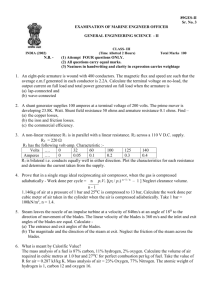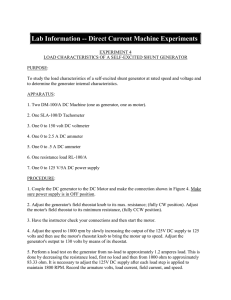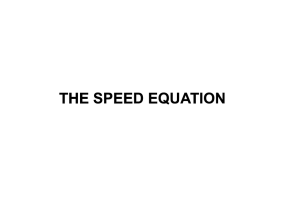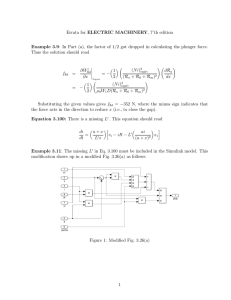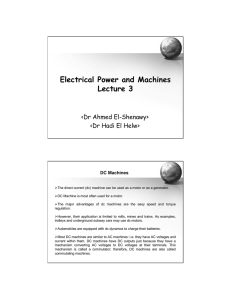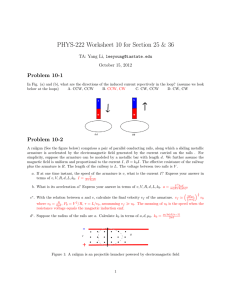9-24. Assuming that the generator in Problem 9
advertisement
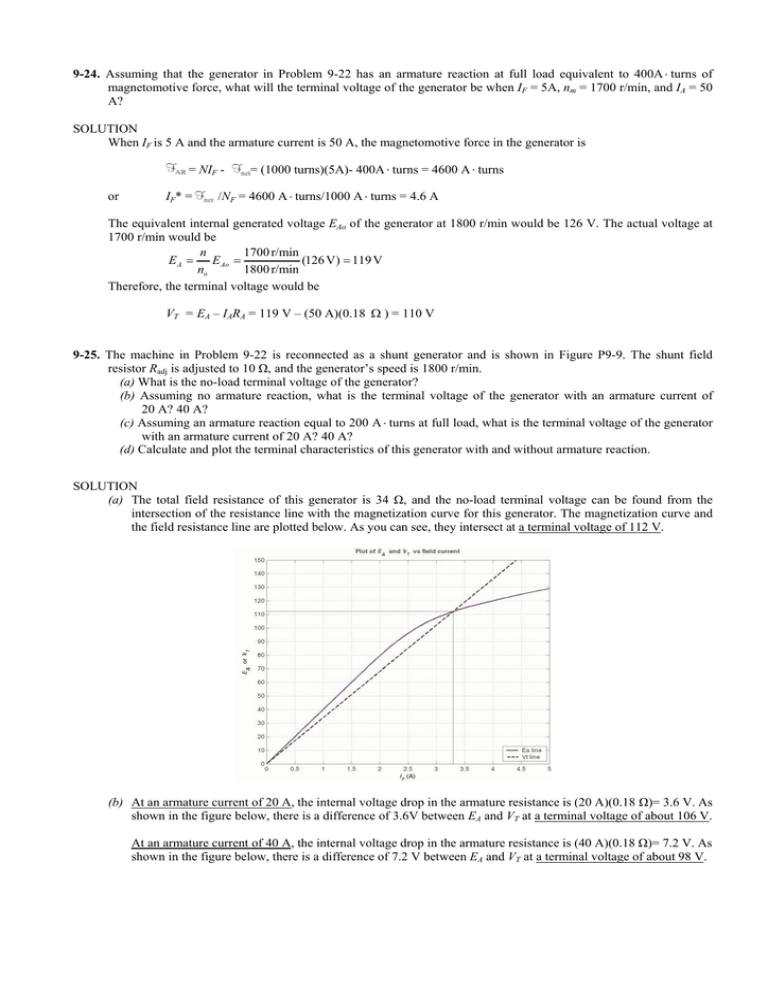
9-24. Assuming that the generator in Problem 9-22 has an armature reaction at full load equivalent to 400A ⋅ turns of magnetomotive force, what will the terminal voltage of the generator be when IF = 5A, nm = 1700 r/min, and IA = 50 A? SOLUTION When IF is 5 A and the armature current is 50 A, the magnetomotive force in the generator is = NIF or I F* = = (1000 turns)(5A)- 400A ⋅ turns = 4600 A ⋅ turns /NF = 4600 A ⋅ turns/1000 A ⋅ turns = 4.6 A The equivalent internal generated voltage EAo of the generator at 1800 r/min would be 126 V. The actual voltage at 1700 r/min would be n 1700 r/min E A = E Ao = (126 V) = 119 V no 1800 r/min Therefore, the terminal voltage would be VT = EA – IARA = 119 V – (50 A)(0.18 Ω ) = 110 V 9-25. The machine in Problem 9-22 is reconnected as a shunt generator and is shown in Figure P9-9. The shunt field resistor Radj is adjusted to 10 Ω, and the generator’s speed is 1800 r/min. (a) What is the no-load terminal voltage of the generator? (b) Assuming no armature reaction, what is the terminal voltage of the generator with an armature current of 20 A? 40 A? (c) Assuming an armature reaction equal to 200 A ⋅ turns at full load, what is the terminal voltage of the generator with an armature current of 20 A? 40 A? (d) Calculate and plot the terminal characteristics of this generator with and without armature reaction. SOLUTION (a) The total field resistance of this generator is 34 Ω, and the no-load terminal voltage can be found from the intersection of the resistance line with the magnetization curve for this generator. The magnetization curve and the field resistance line are plotted below. As you can see, they intersect at a terminal voltage of 112 V. (b) At an armature current of 20 A, the internal voltage drop in the armature resistance is (20 A)(0.18 Ω)= 3.6 V. As shown in the figure below, there is a difference of 3.6V between EA and VT at a terminal voltage of about 106 V. At an armature current of 40 A, the internal voltage drop in the armature resistance is (40 A)(0.18 Ω)= 7.2 V. As shown in the figure below, there is a difference of 7.2 V between EA and VT at a terminal voltage of about 98 V. At an armature current of 20 A At an armature current of 40 A (c) The rated current of this generated is 50 A, so 20 A is 40% of full load. If the full load armature reaction is 300 A ⋅ turns, and if the armature reaction is assumed to change linearly with armature current, then the armature reaction will be 120 A ⋅ turns. The figure below shows that a triangle consisting of 3.6 V and (120 A ⋅ turns)/(1000 turns) = 0.12 A fits exactly between the EA and VT lines at a terminal voltage of 100.78 V (EA = 104.37 V, IF = 2.96 A and IF* = 2.84 A ). Plot of E A and V T vs field current 150 140 130 120 110 100 E A or V T 90 80 70 60 50 40 30 20 Ea line Vt line 10 0 0 0.5 1 1.5 2 2.5 I (A) 3 3.5 4 4.5 5 F The rated current of this generated is 50 A, so 40 A is 80% of full load. If the full load armature reaction is 300 A ⋅ turns, and if the armature reaction is assumed to change linearly with armature current, then the armature reaction will be 240 A ⋅ turns. There is no point where a triangle consisting of 7.2 V and (160 A ⋅ turns)/(1000 turns) = 0.24 A fits exactly between the EA and VT lines, so this is not a stable operating condition. (d) The resulting terminal characteristic of this generator with and without armature reaction is shown below: Terminal Characteristic of a Shunt DC Generator w/AR 120 100 VT (V) 80 60 40 20 0 0 without armature reaction 5 10 15 20 25 IL (A) 30 35 with armature reaction 40 45 50

